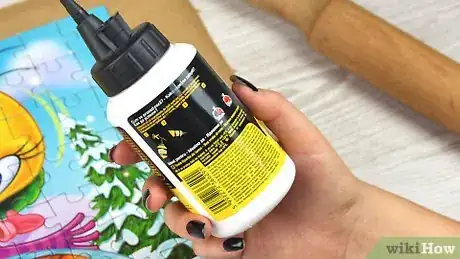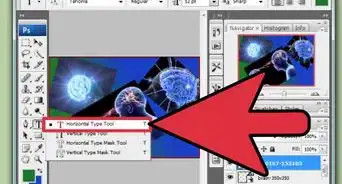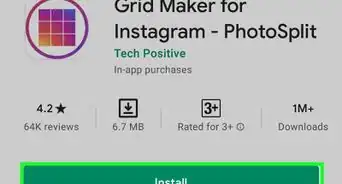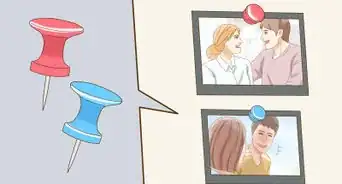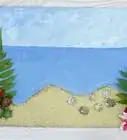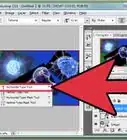This article was co-authored by wikiHow staff writer, Christopher M. Osborne, PhD. Christopher Osborne has been a wikiHow Content Creator since 2015. He is also a historian who holds a PhD from The University of Notre Dame and has taught at universities in and around Pittsburgh, PA. His scholarly publications and presentations focus on his research interests in early American history, but Chris also enjoys the challenges and rewards of writing wikiHow articles on a wide range of subjects.
The wikiHow Video Team also followed the article's instructions and verified that they work.
This article has been viewed 250,721 times.
Learn more...
If you ever put together a jigsaw puzzle and decide it’s too pretty to take apart, grab a bottle of puzzle glue! Mod Podge Puzzle Saver is one of the best-known options, and it’s very easy to apply with a foam paintbrush. Lay down some wax paper to make cleanup easier, add a few coats of Mod Podge to the front and back of the assembled puzzle, and think about how you want to display your piece of puzzle art!
Steps
Setting up the Puzzle and Work Surface
-
1Assemble the puzzle on wax paper if you plan to preserve it. If you think you’ll want to permanently preserve a jigsaw puzzle once it’s finished, go ahead and build it right on top of one or more sheets of wax paper. Check the finished dimensions of the puzzle on the box and create a wax paper work surface that’s at least 2 in (5.1 cm) bigger on all sides.[1]
- For instance, if the finished puzzle has listed dimensions of 18 by 24 in (46 by 61 cm), tear off overlapping strips of wax paper to create a work surface that’s at least 20 by 26 in (51 by 66 cm)
- Laying wax paper underneath the puzzle keeps sticky Mod Podge from getting all over your table, counter, desk, floor, or other puzzle-assembly surface. Mod Podge isn’t too hard to wipe away when it’s wet, but really tough to remove once it dries!
-
2Slide wax paper under the puzzle if you’ve already assembled it. You may not realize you want to preserve a jigsaw puzzle until after you’ve assembled it. In this case, rip off one or more strips of wax paper—depending on the size of the puzzle—and carefully shimmy and slide them under the puzzle’s edges. Extend the wax paper beyond all the puzzle’s edges by at least 2 in (5.1 cm), and make sure the entire underside of the puzzle is resting on wax paper.[2]
- Mod Podge may soak all the way through puzzle pieces that are made of thin cardboard. If you don’t put wax paper underneath, the pieces may get glued to your table!
Advertisement -
3Roll over the puzzle with a rolling pin to smooth it out. Jigsaw puzzles tend to be a bit lumpy and/or wavy due to all the irregular joints among the pieces. Give the entire puzzle surface a few rolls back and forth with a kitchen rolling pin to flatten it.[3]
- A wine bottle or can of food will also do the job.
Brushing on the First Coat
-
1Use Mod Podge Puzzle Saver for the best results. There are several varieties of Mod Podge brand products, but Puzzle Saver is definitely the best choice for this job. It comes in a large plastic jar, which is enough for at least a dozen puzzles, and a small plastic jar, which will serve at least a couple of puzzles.[4]
- Look for Mod Podge Puzzle Saver at craft stores and “big box” retailers with crafting departments.
-
2Dip a foam-tipped paintbrush into the Mod Podge. You have 2 options here: either choose a foam-tipped brush that’s small enough to fit into the Mod Podge jar, or pour some of the Mod Podge into a bowl and use a larger brush. In either case, only dip the tip of the brush into the Mod Podge, since the first coat on the puzzle should be a thin one.[5]
- Pick up foam-tipped paintbrushes at craft stores or hardware stores. They’re inexpensive, so buy at least 2 or 3 for a single puzzle project.
-
3Brush a thin layer of Mod Podge over the puzzle with smooth, even strokes. Dip the foam brush tip back into the Mod Podge after every few strokes, as needed. While covering the whole puzzle surface in a thin layer of Mod Podge is what’s most important here, using long, steady strokes may reduce the number of brush marks you’ll have to sand away later on.[6]
- Mod Podge Puzzle Saver is semi-translucent white in the jar and when you first apply it—but don’t worry, it becomes transparent when it dries!
-
4Save the paintbrush in a zip-close bag or discard it after finishing the first coat. Foam-tipped paintbrushes are cheap enough that you may be fine with using a new one for each coat of Mod Podge you apply. Otherwise, seal the used brush in a zip-close bag until it’s time to apply the next coat.[7]
- If you try to clean the brush with water it won’t dry in time for the second coat.
-
5Allow the first layer to dry for 15-20 minutes. Mod Podge is mostly dry once it goes from translucent white to transparent. Press your fingertip to several spots around the puzzle surface—if the Mod Podge is slightly tacky but not sticky, it’s ready for the second coat.[8]
- Mod Podge may take slightly longer to dry in humid conditions.
Applying Additional Coats
-
1Apply a second, thicker coat in the same fashion as the first. Dip the foam brush deeper into the Mod Podge this time and brush on more of the material with each stroke. However, don’t just “glop” it onto the puzzle surface—still use steady, even, long brushstrokes.[9]
- Use either a fresh foam paintbrush or the brush from the first coat that you stored in a zip-close bag.
-
2Allow the second coat to dry for at least 30 minutes. Test the puzzle surface with your fingertip to see if the Mod Podge is still tacky. If it is, try again in 5 minutes and repeat as needed. Do not move on to flipping the puzzle until the Mod Podge is no longer tacky.[10]
- The drying time will take longer in humid conditions.
-
3Flip the puzzle over on the wax paper. Carefully lift the puzzle by one edge to start peeling it away from the wax paper. Peel, lift, and flip slowly and steadily to turn the puzzle over on the wax paper. The 2 coats of Mod Podge should be more than enough to keep the puzzle pieces in place as you do this.[11]
- If you want to be extra cautious when flipping the puzzle, grab 2 flat sheets of cardboard that are larger than the puzzle. Slide the wax paper and puzzle onto one sheet of cardboard, lay the other sheet on top, and flip the entire “sandwich” over. Remove the cardboard sheets, peel away the wax paper, and slide new sheets of wax paper underneath the now upside-down puzzle.
-
4Brush a thick layer of Mod Podge onto the back of the puzzle. Style points don’t count this time around! Just be sure to give the entire back of the puzzle a good coating of Mod Podge. This coating is simply extra protection to further ensure that the puzzle remains permanently stuck together.[12]
- Some crafters skip this step altogether without any problems. Think of it as “Mod Podge insurance” that’s recommended but not essential.
-
5Turn the puzzle back over after 15-20 minutes. Test with your fingertip to make sure the Mod Podge is only slightly tacky. As you lift the puzzle, peel away the wax paper if it’s stuck to the edge at all, then flip the puzzle right-side up. Place it on the wax paper once again.[13]
Cleaning and Displaying the Puzzle
-
1Scrape off any excess glue along the edges with a crafting knife. You’ll likely have some dried Mod Podge that extends over the edges of the jigsaw puzzle. To remove it, lift one edge of the puzzle at a time and gently press a razor knife or other sharp crafting knife to the side of the edge (that is, not the top or bottom surface of the puzzle). Slide the blade along the edge, using gentle, even pressure, to scrape away the excess glue.[14]
- Work carefully so you don’t cut into the puzzle—or cut yourself!
- If you intend to frame the puzzle, feel free to skip this step and instead simply peel off any larger bits of overhanging glue with your fingers.
-
2Sand away any brush marks with #0000 steel wool. Even if you have an exceptional Mod Podge brushing technique, there will still be some dried brush marks visible on the glossy puzzle surface. Grab a piece of #0000 steel wool (which is the ultra superfine type) and gently and evenly work it over the surface with small circular motions.[15]
- Brush away any resulting dust on the surface with a clean cloth, or just take a deep breath and blow it off of the surface.
- Ultra superfine (#0000) steel wool is available at craft stores and online.
-
3Display the jigsaw puzzle as-is or frame it. With 2 coats of Mod Podge on the front and 1 on the back, your puzzle will be plenty sturdy to display simply by tacking or taping it to a wall. However, to add a bit more elegance to your display, buy a picture frame that’s large enough to hold your completed puzzle.[16]
- As another display option, consider laying the puzzle on a wooden tabletop and then installing a glass tabletop over it.
Community Q&A
-
QuestionWill mod podge affect a glow in the dark puzzle? Will it still glow in the dark?
 Community AnswerIt is not likely to affect the glow-in-the-dark effect.
Community AnswerIt is not likely to affect the glow-in-the-dark effect. -
QuestionCan I frame a finished puzzle that has been mod-podged?
 Community AnswerYes, you can! We've done 2 now, both of which were good size puzzles, and they turned out amazing! We're getting ready to do our 3rd. They look gorgeous framed!
Community AnswerYes, you can! We've done 2 now, both of which were good size puzzles, and they turned out amazing! We're getting ready to do our 3rd. They look gorgeous framed! -
QuestionCan I use Mod Podge sealer spray?
 Community AnswerIt won't work as well as the glue, but you can try.
Community AnswerIt won't work as well as the glue, but you can try.
Things You’ll Need
- Mod Podge Puzzle Saver
- Foam-tipped paintbrushes
- Wax paper
- Crafting knife
- Utra superfine (#0000) steel wool
- Picture frame (optional)
References
- ↑ https://modpodgerocksblog.com/how-to-use-puzzle-glue/
- ↑ https://modpodgerocksblog.com/how-to-use-puzzle-glue/
- ↑ https://betweennapsontheporch.net/how-to-save-or-frame-a-jigsaw-puzzle-without-using-messy-glues/
- ↑ https://modpodgerocksblog.com/how-to-use-puzzle-glue/
- ↑ https://modpodgerocksblog.com/how-to-use-puzzle-glue/
- ↑ https://modpodgerocksblog.com/how-to-use-puzzle-glue/
- ↑ https://modpodgerocksblog.com/how-to-use-puzzle-glue/
- ↑ https://modpodgerocksblog.com/how-to-use-puzzle-glue/
- ↑ https://ourpastimes.com/puzzle-together-using-mod-podge-4601343.html
- ↑ https://ourpastimes.com/puzzle-together-using-mod-podge-4601343.html
- ↑ https://ourpastimes.com/puzzle-together-using-mod-podge-4601343.html
- ↑ https://ourpastimes.com/puzzle-together-using-mod-podge-4601343.html
- ↑ https://ourpastimes.com/puzzle-together-using-mod-podge-4601343.html
- ↑ https://youtu.be/MVrJ4pAMrKg?t=985
- ↑ https://modpodgerocksblog.com/how-to-use-puzzle-glue/
- ↑ https://modpodgerocksblog.com/how-to-use-puzzle-glue/
About This Article
To modge podge a puzzle, you’ll need some wax paper, modge podge puzzle saver, and a foam-tipped paintbrush. First, you’ll need to slide a sheet of wax paper under your puzzle. Then, spread a thin coat of modge podge over your puzzle. Don’t worry if it appears white at first, since it will dry translucent after 15 to 20 minutes. Once the first coat is dry, you should apply a second thicker coat, which will need at least 30 minutes to dry. After the second coat is dry, gently flip the puzzle over on the wax paper. Apply a thick coat of modge podge to the back of your puzzle, then flip it back over after 20 minutes. For tips on how to remove any modge podge that’s sticking to the side of your puzzle, read on!

